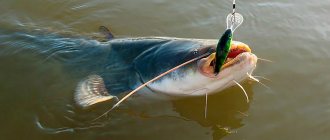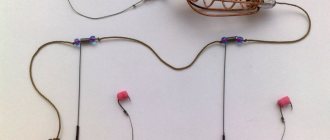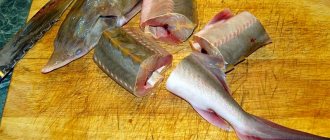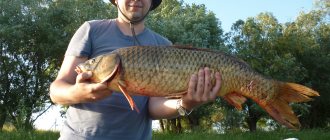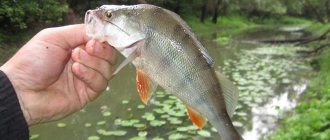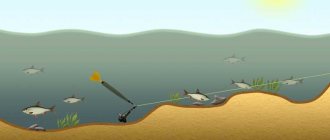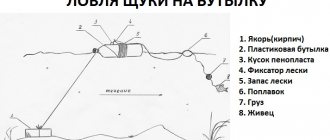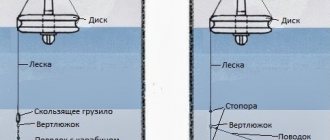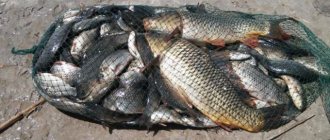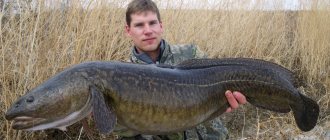A fishing device for catching fish from the bottom of a river or lake is called a donka and a bottom fishing rod.
A special feature of the equipment is the use of a spinning rod for casting, as well as manual casting without auxiliary resources.
The main elements for the process are a sinker at the end of the main line and 2-3 hooks with leads of different lengths.
How and where to fish with donka?
Considering the types of gear, the processes of casting them are radically different.
Casting with a rod:
- A sinker and hooks are attached to the end of the rod's main line
- With the help of a reel , the tackle is pulled to the end.
- The adjusting ring on the line receiver opens and the line is pressed with the index finger to the base of the rod.
- The end of the fishing rod is retracted behind the back at an angle of 45-60 degrees, and sharply directed towards the reservoir. At the same time, the finger holding the line is released to freely unwind it from the reel.
- After the load is immersed to the bottom , the line is reeled in until the line is taut, and a bite indicator is attached to the end.
Manual method:
- Initially , it is necessary to correctly unwind and lay out the fishing line and tackle from the reel.
- Before casting, select an area of land that is free of vegetation or other obstacles that could cause the gear to snag.
- The fishing line is carefully laid simply on the shore in a ring or zigzag method, but with a margin relative to the casting distance.
- The tackle is taken in the right hand , and the fishing line is held in the left hand, and gradually waving the hand, adding amplitude, the cast occurs (the optimal degree ratio of the tackle relative to the surface of the reservoir is 30-50°).
- When it is at the bottom , you can reel the line onto the reel until it is taut and attach the alarm to it.
Where to catch:
- In places with great depth.
- The undesirable presence of snags or excess vegetation at the bottom of the reservoir.
- There should be no trees with overhanging branches on the shore or near the fishing site
- If fishing involves hunting for predatory fish , it is advisable to choose places with rifts and near thickets and accumulations of snags.
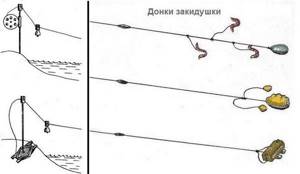
Bait for donk fishing
The only thing you can never have too much of is bait. I often pair something tasty (exclusively of animal origin) not so much with fish, but with the body of water and the season. For example, the pearl barley shell and the large false horse leech work perfectly well in the rivers of the southern basin, but in the northern rivers the result is exactly the opposite. Grams (brook lamprey larvae), oddly enough, even with their hyperactivity on the hook, sometimes failed on southern rivers, and in the cool waters of northern reservoirs they attracted fish like a magnet. Live bait and a small frog worked the same way almost everywhere, but these are clearly seasonal baits, which is probably due to the food preferences of predatory and large white fish according to the seasons. Naturally, the worm is universal for donkey in all seasons, but it also has its drawbacks. If there are a lot of ruffs, gobies or minnows in the river, then they can completely ruin the whole bottom fishing, pulling the bait off the hook in a matter of minutes. Of all the variety of worms, I single out the large crawler, which is truly universal for donkeys; any river fish can be caught with it, and it is too tough for harmful little things.
True, getting it can be more difficult than catching fish, but, as they say, without difficulty... It is worth emphasizing the merits of the beetle (chafer larva), which makes the entire catch in certain seasons. The larva and the beetle itself are easy to obtain; just a small shovel and a dung heap near the farm are enough. Such an excellent bait for donkey is perfectly stored in a bucket of rotted manure both in the summer heat and in the autumn cool, it holds perfectly on the hook and is not at all afraid of water. It still has some small drawbacks - not every fish likes it and small fish are too tough for it, which, however, can be called an advantage. I have not yet tested rare and exotic baits such as mole crickets, capelin, squid, fried birds and silicone worms, and even without them there is an unplowed field for experiments.
Fishing from a boat
There is no need for a long rod, all you need is a meter stick with a suitable end to guide the line away from the surface of the boat to prevent damage to both surfaces.
Casting is done manually, because on a boat you can get quite close to the fishing spot.
One condition or wish is to cast the tackle in the opposite direction of the tackle relative to the anchor and, accordingly, the current.
This allows for more accurate bite visibility.
Types of equipment:
- Sliding feeder - freely attached to the fishing line, which allows you to increase sensitivity when biting.
- The fixed hook is tightly attached and does not move freely, unlike the previous one.
- The tube prevents the line from getting tangled when casting.
- Paternoster, a rig that shows the bite well, collecting a lot of fish near it. Attached both to the fishing line and separately from it.
- Loops
- Inline - a sliding mount for the feeder, is a loop made on the feeder.
- A combine is a piece of gear in the form of a spring to which hooks are attached to a thick fishing line.
- Helicopter, bait, mostly homemade from a tin can.
Advantages and disadvantages
- Manufacturing does not require a large number of components.
- Easy to assemble.
- The versatility of the tackle allows you to catch different types of fish.
- The tackle is located on the bottom in exactly the designated place.
- Used when fishing from the shore and boat.
- Durability.
Nuances:
- When casting by hand , you must ensure that the laid line is correctly reeled from the shore.
- The process requires some skill so that the fisherman does not get injured.
Spinning rods for donkey

Initially, the classic donka was an exclusively hand-made tackle. However, later spinning rods, the reel of which was actually used instead of a reel, became very popular.
With minor modifications, the donkey spinning rod began to be called a feeder. This type of tackle is very popular today and allows you to catch a variety of large fish. The popularity of the feeder is explained by the ease of fishing, the availability of gear and the ability to catch maximum trophies. At the same time, it is necessary to take into account that the feeder is a rather specific piece of equipment, which in unfamiliar conditions on new lakes and rivers may not give any results at all. But in those places where anglers often fish with a feeder, its effectiveness is at a high level.
Using a spinning rod for donkey allows you to significantly simplify the process of throwing bait. In this case, there is no need to use expensive reels, which are necessary for classic spinning. We also note that the process of landing fish has been significantly simplified. If previously, when using a reel, everything actually had to be done manually, then with the use of a spinning rod and reel you can optimally catch even the strongest fish. The risk of fish falling off the hook is reduced, since you can optimally select the line tension when landing fish.
About 50 meters of fishing line with a thickness of 0.3 meters is wound onto the reel. The leashes are attached to the main line using a carabiner, and the heavy weight makes it easy to cast to the maximum possible distance. In total, when purchasing Chinese reels, the total cost of the gear can be several tens of dollars.
Kinds
There are several varieties:
Classic version
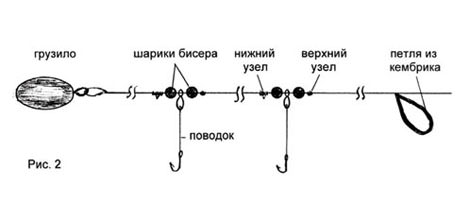
It consists of one permanently fixed or sliding sinker at the end of the fishing line and several retractable hooks.
Donka with shock-absorbing elastic band
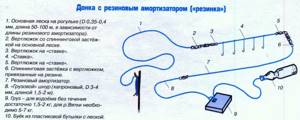
It assumes the presence of a small piece of elastic attached between the sinker and the fishing line using a carabiner with swivels. This nuance allows the fish to hook itself when biting.
Tackle with feeder
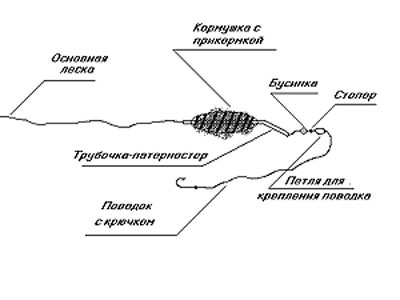
Thanks to the additional element , the fish are attracted not only by the bait on the hooks, but also by the bait base of porridge stuffed into the feeder.
Donk pike: how to make it yourself, fishing technique
As technology improved, high-quality spinning rods became available to every angler. As a result, this gear has become the main tool for hunting pike, displacing the float rod, which is used to successfully catch this predator with live bait . But few people know that good results can be achieved with a bottom fishing rod.
Catching pike on a donk
Donka for pike is rarely used in fishing , but in some situations it turns out to be very catchy . Bottom tackle for pike with live bait has a number of advantages :
- it allows you to make long casts;
- It is convenient to fish with it in deep areas, including in the current ;
- This gear does not require constant monitoring .
Using a donkey, you can cast bait over a long distance when fishing from the shore. If the weight of the sinker is selected correctly , the equipment will remain at the selected point at any depth and strength of the current.
Since the donka does not require constant monitoring , it can be used as additional tackle. To do this, it is enough to make a cast and place alarm , which is usually used as a bell .
But the bottom fishing rod also has significant disadvantages :
- it is less mobile than a spinning rod or a float rod;
- Donka limits the freedom of live bait more than float tackle;
- it is prone to getting caught on the bottom.
With a donka it is not so easy to change the fishing point if there are no bites. It also does not allow you to maneuver the live bait, moving it in the horizontal and vertical planes. When fishing with a float rod, you can always move a fish attached to a hook over the snags, but a donka does not provide .
When fishing for pike on the bottom, you can use not only live bait, but also dead fish as bait. This attachment can also be purchased at a grocery store - frozen capelin, herring and other types of fish of suitable size are suitable.
It is preferable to use donka in those periods when pike are passive - early spring, late autumn and winter.
Donka for pike with your own hands
To make a donk for casting, you can take a spinning rod and a spinning reel. In this case, the spinning test must correspond to the weight of the sinkers used, which can exceed 100 g
If possible, you should prefer a medium or medium-fast action rod. Fast and ultra-fast blanks do not provide any advantages when fishing from the bottom; at the same time, when using them, decreases and it becomes more difficult .
To provide bottom braid must be used as the main fishing line . But it is not necessary - monofilament of a suitable diameter will be quite sufficient.
To mount the simplest equipment for catching pike on a donk, you need :
- At the end of the main fishing line, attach a metal leash with a double or triple hook through a swivel;
- Tie a fishing line with a sinker at the end to the swivel.
To make fishing more effective , you need to use more advanced equipment options. The use of a sliding sinker will make the donk more sensitive and will help you get a good catch, since the pike will not feel resistance at the moment of biting. Making such gear is not too difficult:
- you need to put a sliding sinker and a bump stop on the main line;
- tie a swivel and mount a leash from a fishing line;
- At the end of the leash there should be a metal leash with a hook.
To prevent live bait from burying itself in the bottom after casting, it is necessary to use a float . There are two options for installing such equipment.
The first assumes that sliding sinker is put on the main line, then there are two stoppers , between them there is a leash on which the live bait is placed. A float is attached to the end of the fishing line.
In the second installation option, a sinker . Above it there are two stoppers , between which a leash runs, and a sliding float.
When fishing from a boat, it is not necessary to use a float to prevent the bait from sinking to the bottom.
If the sinker is located at the end of the main line, and the leash with bait is attached above it, it is enough to keep the equipment taut after casting .
Also well suited for pike hunting is a variety of donka, which is commonly called rubber . To do it, you need:
- on the main line, at a distance of a meter from each other, place two stoppers, between which the leash slides;
- tie a fastener with a swivel to the end of the main fishing line, and to it - rubber with a diameter of about 1.5 mm and a length of 7-8 meters or more;
- attach a piece of three-millimeter nylon cord 1-2 m long to the rubber;
- Place a sinker at the end of the cord, the weight of which can be 150-200 grams or more.
When fishing with an elastic band a rod and reel are usually not used . Before casting, the fishing line is laid out in circles on a flat surface.
Donka for pike with your own hands: video
How to make a donk for pike below:
Fishing technique
You can catch pike in its typical habitats:
- in snags;
- on the borders of grass thickets;
- on pits and edges.
Fishing conditions in which donka is preferable to other gear for catching pike include:
- snags located at depth;
- deep holes;
- areas with fast currents.
It is important correctly so that it stays firmly on the hook and remains active for a long time.
To do this, you can pass the leash through the gills so that it comes out through the mouth , and then attach a double hook .
After this, you need to pull the leash back so that the double sits tightly in the corner of the baitfish’s mouth.
Catching pike on a donk does not require the constant participation of an angler .
After casting the equipment, you can set a bite alarm and switch to float, feeder or spinning fishing.
You can fish in a more active style, making frequent casts to find fish, but in this case you will have to change live bait .
The opposite option is to place one or several donks and check them every hour or two or less, without monitoring the bites at all. A pike that has swallowed live bait sits on the hook itself .
Catching pike on a donk is an unusual and interesting way of fishing. In some situations this tackle provides the best results, in others you can try it just out of curiosity . In any case, with the right approach, catching pike on a donk turns out to be very productive .
Device and equipment
Rod
For this fishing method you need a small rod, 1.5-2.2m long with high strength values. It should have several guide rings for fishing line (3-5 pieces) and have a reel.
The tip in some cases is modified, or rather, replaced with a steel pin 20-30 cm long, which subsequently serves as an element for placement in the ground and holds the complex tackle.
If this is not expected, the ending should be hard with a test value of at least 20-25g.
You can improve the ending by attaching to it and passing through the “tulip” a steel spring nod, which perfectly passes the fishing line through its interior and becomes a bite alarm, since any type of bottom tackle does not provide for the presence of floats.
fishing line
Its thickness must meet tensile test requirements , and given the severity of the load, it is recommended to use a main line with a diameter of 0.3-0.7mm (for large catfish or carp, a diameter of 1mm is suitable).
A sufficient thickness of the leader line is from 0.15 to 0.2mm.
Cargo
Pebble weights
To cast gear over a long distance from the shore, you need sinkers from 30 to 130g. The weight is adjusted depending on the strength of the current directly at the fishing spot. The shape can be different - conical, round, flat, oval...
When fishing from a boat , the weight of the load may not be so significant, but it may not be similar to the float values.
Bait and lure
Plant and animal ingredients are used as bait material:
- red or white worm;
- maggot;
- airy dough or special plasticine;
- boiled corn, wheat, peas;
- live bait;
If you use a donk with a feeder, you need to prepare a homemade multi-component porridge or mix a dry store-bought mixture directly on the pond.
Hooks
The selection of hooks of the required size and shape depends on the expected weight of the catch, but the average acceptable option is: No. 6 -10 according to domestic numbering.
Donkey design
The basis of the donkey design is a fishing line 10-30 meters long with a diameter of 0.5-0.6 mm. At the end there is a long loop for attaching a blind sinker. Ten to fifteen centimeters from it there is a side loop for a leash. My experiments with attaching leashes through swivels and various kinds of anti-twisters ended in complete failure; on a simple hook they turned out to be the main creators of “beards”. Therefore, I attach the leash in the simplest and most reliable way - loop to loop . Line on leashes 30-40 cm long is moderately hard, 0.30-0.35 mm of any color. A fish with a vein of this diameter is not afraid at all in the twilight and at night, but thinner ones (especially braided ones) become chronically and hopelessly entangled. When choosing hooks, I only bother when fishing for catfish and ruff. With catfish, everything is clear, it needs a well-sharpened hook from a small crane, and for a nosar you need a small hook, but with an elongated shank. In other cases, I prefer an elastic hook, No. 8-10 (according to the recommended numbering) with serrations on the fore-end. However, the shape is not so important, the main thing is good material and sharpening. When fishing, I always have a couple of dozen spare donkey leashes with various hooks in my pocket, and along the way I quickly adapt to both the bait and the fish. And another irreplaceable pocket item - a fine-grained block - helps in literally a couple of movements to correct (not sharpen) the factory sharpening slightly damaged during fishing, which is of great importance for tackle that does not imply an instant hook when biting.
A couple of meters above the leash on the main fishing line, I tie another side loop or tighten a piece of a match into the loop - a noose - a very important element that serves to hold grass, fallen leaves and other debris floating along the river from sliding onto the leash. I also tie a long loop at the shore end of the main line.
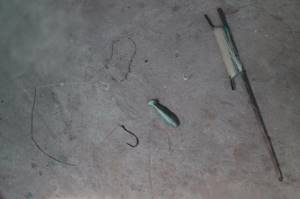
Criterias of choice
- Before purchasing or making your own gear, you need to make sure the quality of all elements.
- It is better to purchase in specialized stores from well-known manufacturers.
- It is necessary to take into account the thickness of the fishing line and the size of the hooks, because the fish, noticing them, becomes shy and should not expect bites.
- The price category should fluctuate in the middle range and above, because low cost implies a lack of quality.
Types of donks
- With rubber shock absorber. It is possible to add bait to an abandoned tackle and remove the catch from the hook without moving the load.
- Returnable (carousel), it does not need to be abandoned. Fishing takes place in one place.
- Running, this donka catches big fish. It fishes in the bottom layer using a sinker, and not, as always, using a float. A spinning rod with a reel and one or two leaders is more suitable.
- Bottom wiring (casting with a feeder), perfect for fishing in deep reservoirs, just like the running one, has a reel and a spinning rod.
- Sheer, also suitable for fishing at great depths, but in quiet currents, a rigid rod with a reel and a single, double or triple hook.
Tips and tricks
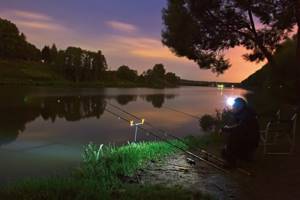
- Before throwing the tackle manually , you need to practice on a regular platform without the main elements.
- Before unwinding the fishing line from the reel , it is advisable to spread a plastic film on the shore, which completely eliminates the possibility of snags.
- It is necessary to constantly monitor the tension of the fishing line and prevent sagging.
- If the bottom is not far away - 10-15 meters from the shore, and is intended for catching small fish - it is better to add bait to the area where it is concentrated.
From the depths you can catch fairly large specimens of underwater inhabitants, but only with the help of a simple tackle - a donkey, because other fishing tackles cannot do this.
Simplicity and ease of use is an additional bonus for the fisherman.
Sinker selection
The optimal shape of a sinker for a donkey is a teardrop shape, which allows for the longest cast. The weight of the cargo can range from 30 to 100 grams. It should be noted that heavy sinkers are easier to cast, so they are more suitable for fishing in fast-flowing rivers. At the same time, it should be borne in mind that the greater the weight of the sinker, the more noise it makes when entering the water. Consequently, cautious fish may leave the fishing spot for a long time. Therefore, if possible, we recommend using weights weighing 30–50 grams.
How to make donka
I'll start by telling you how to make donka at home, rather than buying it in stores.
Donka is perhaps one of the most popular fishing gear. Therefore, to begin with, I decided to talk about the simplest version of donkey. A simple donka does not mean at all that few people can be caught with it; a lot can be caught with such tackle. Therefore, remember, pack and go fishing.
What is needed for donka
How to assemble a donk
So, let's start assembling a simple donkey. To begin, we will tie leashes from fishing line 7-10 cm long to the hooks. All leashes must be tied to the hooks with a Figure Eight knot. Next, we take the main fishing line and tie an “olive” weight to it at the end, also using a figure eight knot. We retreat along the fishing line 30-35cm and knit the first leash with a hook. We retreat another 10cm along the line and tie the next hook. And so does everyone else. After all the hooks are tied, we retreat another 15 cm and tie our carabiner with the same knot. It looks something like this:
All! Donka is ready! We fasten it with a carabiner to the fishing line on the fishing rod, it can be on a reel or a slingshot, it doesn’t matter, you can even tie it to a tree. You attach the bait, cast and catch.
Tips for a novice fisherman
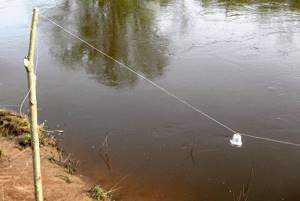
As a short epilogue to our publication, I would like to give some advice to novice fishermen:
- Don't go overboard with the quantity. At first, one piece of gear is enough - first learn how to handle it properly, then increase the quantity.
- Give preference to high-quality, but inexpensive equipment. At first, you shouldn’t invest too much in equipment: choose the required minimum with an optimal price-quality ratio.
- Don't forget about the accompanying equipment. At a minimum, you will need a landing net for large trophies and a cage for caught fish.
- Don't neglect night fishing. Many species of fish (bream, pike perch, catfish) show maximum activity and are excellently caught on the bottom in the dark. In addition, night fishing has a special charm, and there are usually fewer competitors.
- Don't neglect the advice of the pros, but don't follow them recklessly. Each fisherman has his own interesting developments. Always listen to the stories of experienced people, but do not rush to mindlessly follow their advice - to each, as they say, their own.
This is interesting: The most dangerous poisonous plants in the world
Even if everything doesn’t work out right away, because skill comes with personal experience, but with the right approach, even the first fishing trip in your life will turn out to be productive. We hope that our informative article will help you in getting luxurious trophies!
Selection of equipment
Let's try to understand the basic elements of the equipment:
- Rod . If your budget allows, you should definitely opt for a more or less high-quality feeder of medium construction and with an average test - this allows you to differentiate fishing conditions without replacing gear. Over time, you can acquire forms adapted for fishing in various bodies of water and obtaining trophies of various calibers. With a total budget deficit, you can stop at Chinese nameless consumer goods, but quality here is a matter of luck.
- Fishing line . The main thing here is to maintain parity between the strength and invisibility of the equipment. If the use of coarser and more noticeable equipment (for example, braided cord) is allowed downstream, then in reservoirs with standing water, high-quality monofilament thread performs best. In all cases, it is recommended to use almost invisible fluorocarbon for leashes (this is a universal option), but when fishing with a feeder, other options are also possible. When fishing with an elastic band, a safety rope made of large diameter monofilament or braid is additionally used.
- Reel or reel . Reels are used in the simplest fishing lines and elastic bands - these are not even mechanisms, but devices for winding fishing line, which you can make yourself, from any piece of wood or plastic bottle. For a feeder, the best option is a spinning reel with a friction clutch.
- Shock absorber . A shock absorber is necessary for fishing with a rubber donkey - it is its integral structural element. You need to understand that even the highest quality rubber band is subject to rapid wear when exposed to water and intensive use, so it is better to replace it before each fishing trip.
- Sinkers . For this type of gear, fairly heavy weights are usually used. The most massive options are required when fishing with rubber bands: anglers sometimes even use bricks and stones. The weight of the load for a traditional bait is usually limited to 100 grams, and the maximum is designed for fishing downstream. With a feeder, everything is much more complicated: the weight of the sinker (usually in the shape of an olive) is calculated based not only on the speed of the current, but also on the weight of the equipped feeder, the characteristics of the fishing rod and other factors.
- Hooks . Choosing a hook is also not a very simple task: it is selected according to the type of bait and the weight of the intended prey. The most inconspicuous are small singles, but fishing with live bait, for example, requires the use of a double or tee. In this regard, elastic bands are good, allowing you to use up to a dozen leashes with different types of hooks.
This is interesting: Classification of mushrooms table
Bite alarm for donkey
Bite alarms can be simple or complex, from a bell to an electronic device. Visual, audio and combined alarms are used.
Visual indicators:
- A weight is on the line between two rings;
- Pendulum devices;
- Flexible tip;
- Side nod;
- Swingtip.
Sound bite alarms are electronic devices. They are made of plastic. Powered by a small battery. Expensive alarms include a satellite communication device. The signal is sent to the pager and allows you to move 150 m away from the donkey.
Let's celebrate! Combination alarms are also electronic devices. They allow you to both see and hear the moment of a bite, since they emit both a light and a sound signal.
